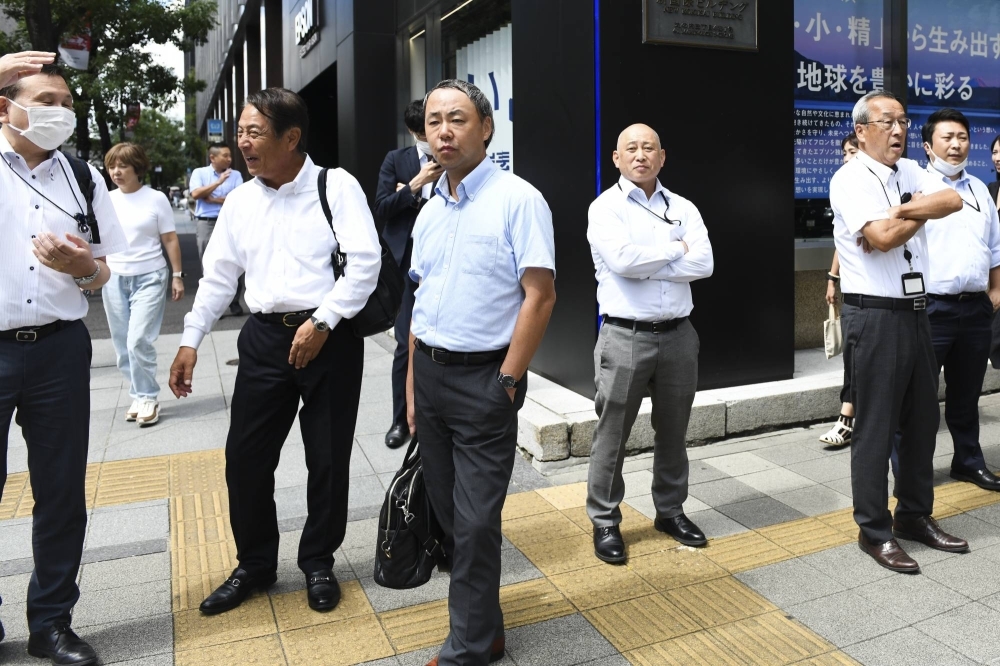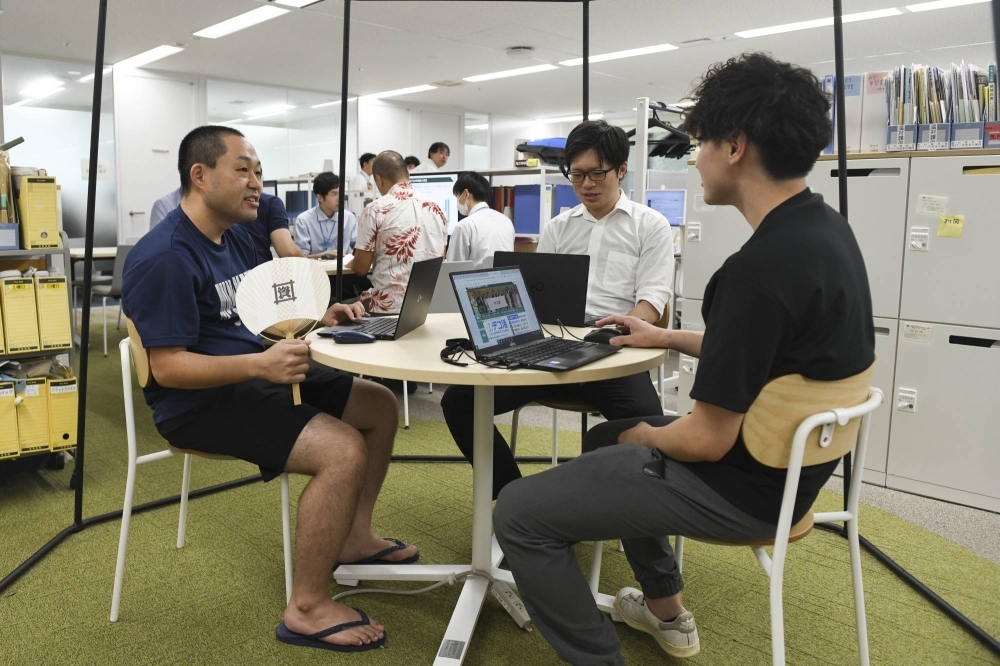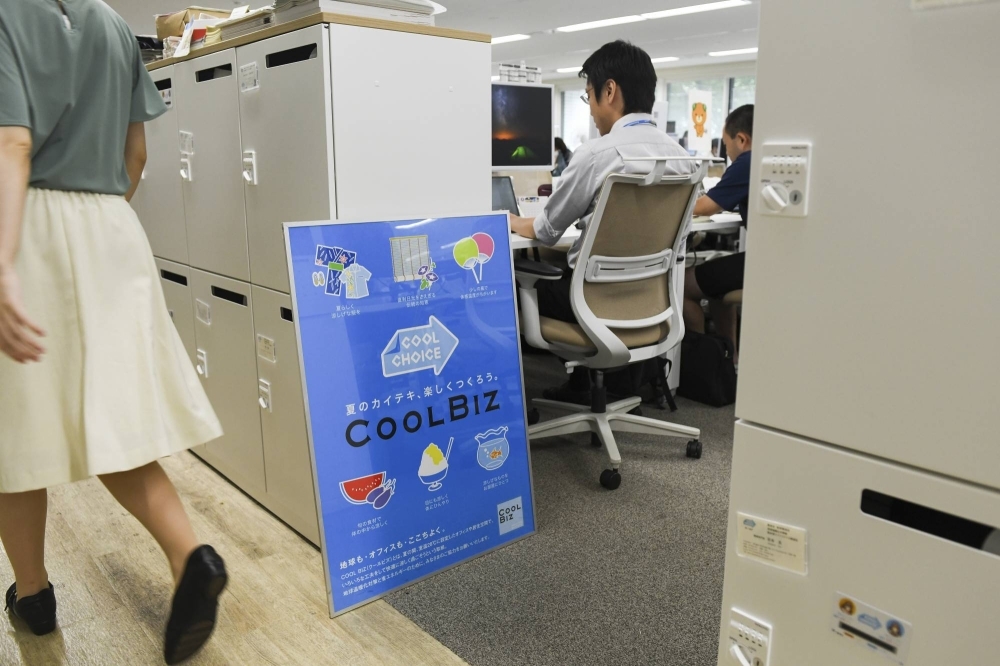It was the tail end of another long, hot Tokyo summer, and salarymen across the city were looking at their wardrobes with dread.
Every year from May to September, Japan’s famously conservative corporate workers and government employees set aside their stiff, dark suits for more casual attire. Out go the neckties and starched shirts; in come short-sleeved polos and linen shirts, even the occasional Hawaiian. Then, as the calendar approaches October, formality returns, if not drastically cooler temperatures.
The metamorphosis is part of a Japanese initiative known as Cool Biz, a glass-half-full description of what could just as easily be called “Hot Office.” Starting May 1, workplaces set their thermostats at 28 degrees Celsius, or above 82 degrees Fahrenheit, to save energy — a sweaty proposition in humid Tokyo.
Uncomfortable though they may be, Japanese offices offer a model for how countries around the world can reduce greenhouse gas emissions that have contributed to record-breaking heat waves and extreme weather events. This August was the hottest ever recorded in Japan, according to its meteorological agency, and daily highs in Tokyo remained above 32 degrees Celsius, or 90 degrees Fahrenheit, into the latter part of September.
Cool Biz is one of a number of simple, cost-effective energy savings initiatives in Japan, a resource-poor country that relies on fuel imports for nearly 90% of its energy needs. The measures have helped keep Japan’s per capita energy consumption to roughly half that of the United States, according to statistics from the Energy Institute, based in London.
Unlike Japanese workers, Americans have been hostile to the idea of thermal discomfort. During the oil shock of the 1970s, President Jimmy Carter became a national punching bag for daring to ask people to turn down the thermostat and put on an extra layer. In the summer, many American offices are still kept so cold that workers resort to space heaters and sweaters.

Office workers in a business district of Tokyo on Sept. 12. Under Cool Biz, salarymen and government workers don short-sleeved shirts in the summer as offices are kept above 28 degrees Celsius to save energy. | NORIKO HAYASHI / THE NEW YORK TIMES
In Japan, Cool Biz became especially popular with women, who tended to wear lighter clothes and often complained about the cold temperatures needed to make business suits comfortable for their male colleagues. Women are still vastly underrepresented in decision-making roles in Japanese offices.
Today, more than 86% of workplaces participate in the Cool Biz program, according to an Environment Ministry survey. The program’s success was achieved without any rule-making or financial incentives, said Yusuke Inoue, the director of the ministry’s zero-carbon lifestyle promotion office.
Instead, the government encouraged politicians and business leaders to strip off their jackets and ties, modeling behavior that quickly became ubiquitous. As people turned to lighter clothes, they no longer wanted the thermostat set so low, Inoue said.
Tatsuya Murase, 29, who works for a shipping company, said clients had come to expect less sartorial stuffiness.
“Nowadays when I visit my clients, all seem to be very flexible and generous about the no-jacket style,” said Murase, who was wearing a blue-and-white-checked button-down shirt as he saw off two colleagues near Tokyo Station on Wednesday.
Keita Janaha, 34, the deputy branch manager of a local bank, said that while some of his male colleagues found the office to be too warm, it was acceptable to customers walking in from the saunalike conditions outside.
Cool Biz traces its roots to the 1970s, when Japanese were heeding some of the same advice that Americans shunned. Even so, the appearance of Prime Minister Masayoshi Ohira in a short-sleeved suit jacket — the “energy-saving look,” as newspapers called it — was considered too unsightly to abide.

Officials at the Environment Ministry, dressed for warm weather, in Tokyo on Sept. 14. Under Cool Biz, salarymen and government workers don short-sleeved shirts in the summer as offices are kept above 28 degrees Celsius to save energy. | NORIKO HAYASHI / THE NEW YORK TIMES
Yuriko Koike, currently governor of Tokyo, introduced Cool Biz to government offices in 2005 during her time as environment minister. The initiative coincided with commitments Japan had made under the Kyoto Protocol, the 1997 international agreement to reduce greenhouse gases.
Learning from Ohira’s safari suit debacle, the government engaged in a full-court press to convince office workers that it was OK to abandon their familiar coat and tie, even when meeting with clients.
The program’s name was chosen from among 3,200 suggestions. Appropriately suave looks were modeled by the colorful prime minister at the time, Junichiro Koizumi. Officials even persuaded Kenshi Hirokane, who wrote a popular comic book about salarymen, to put his characters in short sleeves.
While the initiative led to complaints from necktie manufacturers, which said business had fallen, it was a boon for retailers like Uniqlo, with its line of inexpensive, casual clothing made from lightweight, sweat-wicking fabrics. Its polos have become the de facto summer uniform for many office workers.
The program has been so successful that it has led to a broader “casualization” of summer style in Japan, said W. David Marx, the author of a cultural history of Japanese menswear, “Ametora: How Japan Saved American Style.”
“As much as it’s an environmental-saving technique, also, on a personal level, I think, everybody realizes that it’s too hot to wear suits,” he said.
Cool Biz’s wintertime counterpart, Warm Biz, introduced at the same time and encouraging workplaces to keep thermostats low, has been less successful. Even its cartoon mascot — an adorable ninja — has had a hard time persuading office employees to bundle up in scarves and blankets and shiver at their desks.

A poster promoting the Cool Biz campaign inside the Environment Ministry in Tokyo, on Sept. 14. Under Cool Biz, salarymen and government workers don short-sleeved shirts in the summer as offices are kept above 28 degrees Celsius to save energy. | NORIKO HAYASHI / THE NEW YORK TIMES
As Cool Biz has thrived, it has also evolved. In 2011, after the nuclear disaster at Fukushima prompted Japan to shut down reactors nationwide, the country loosened dress standards once more and called on its citizens to reduce air conditioner use even further in an effort to avoid rolling blackouts.
So-called Super Cool Biz helped save the electric grid but may not have been great for productivity, according to research that found that workers became less productive with every additional degree above 25 Celsius, or 77 Fahrenheit. Even more worrying, one study linked the reduction in home cooling to a rise in mortality among older people from heatstroke.
Last year, with Japanese summers getting longer and hotter, the Environment Ministry did away with the official campaign period, encouraging workplaces to naturally transition from Cool Biz to Warm Biz as temperatures demand. Still, most office workers don their casual attire in May and don’t switch back to more formal wear until the end of September. Some municipalities have said they will continue Cool Biz into October.
Not everyone has adjusted well to the change, said Yoshiyuki Morii, a fashion consultant who helps companies and their employees navigate the country’s shifting dress norms.
In a nation where uniforms were once common even in desk jobs, many people are unsure what constitutes appropriate attire in the Cool Biz era, he said. It’s a problem that can have serious implications: In 2019, business-suited South Korean trade officials accused their short-sleeved Japanese counterparts of disrespect.
Other countries have tried programs similar to Cool Biz, with varying degrees of success. In Spain, the public proved less willing to put up with the heat, said Daniel Sánchez García, a professor at the University Carlos III in Madrid who studies thermal comfort.
When the Spanish government introduced the program, “people said that 27 degrees” — nearly 81 degrees Fahrenheit — “was too high,” he said.
Even in Japan, not all buildings are cooled equally: Shops and restaurants tend to keep their thermostats low to ensure their customers’ comfort.
Masato Ikehata, a spokesperson for Itochu, a trading company that relaxed its business suit policy in 2017, said the firm had set up special “cold compartments” where employees and clients can cool down after entering the building and before holding meetings in the warmer office spaces.
The soaring temperatures have prompted a host of other adaptations. Personal air conditioners hung on lanyards; hand-held electric fans and collars filled with cold packs are common accessories. Construction and delivery workers have taken to wearing vests with two small electric fans sewn in.
At EAT Grill and Bar, a Western-style cafe in central Tokyo, the owner, Michikazu Takahashi, keeps the thermostat at 28 degrees.
Some customers feel that’s too warm, he said on a recent day as he took a break from the hot grill. “They say this isn’t normal,” Takahashi said, gesturing to his shop, where a small shiba inu named Momo reclined comfortably on the wooden floor.
He disagreed. Freezing temperatures on a hot summer day? “That’s what’s not normal.”
Source: The Japan Times


